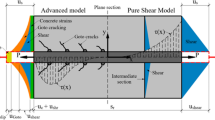Abstract
The respective key-note presentation will highlight the results recently obtained by the research group on predicting the serviceability behaviour of RC members. The presentation will consist of three main parts: 1) A new bond-slip model. 2) A new deflection model for concrete bending members reinforced with steel or FRP bars and steel fibres. 3) A novel crack model termed the Strain Compliance Crack (SCC) model. The current paper will be limited to the description of the latter crack model. It accounts for the specifics of primary and secondary crack spacing and width analyses in RC beams, as demonstrated by testing. The reinforcement strain profile is used to predict crack spacing, which is the primary emphasis of the model. The model includes a novel concept of the limit effective depth, dlim, to classify crack types. For small beams (d ≤ dlim), only primary bending cracks are examined, whereas secondary cracks are addressed for large beams (d > dlim). Parameter dlim is influenced by the reinforcement ratio, modular ratio, cover, and bar diameter. Although the model may estimate the mean spacing between primary and secondary cracks, only primary cracks are used for calculating crack width. For small beams, the crack width profile is a straight line. It is presumed that the width profile of major cracks in large beams is bilinear (including fish-shaped). The proposed model accurately predicted crack spacing and width, which corresponded with experimental findings.
Access this chapter
Tax calculation will be finalised at checkout
Purchases are for personal use only
Similar content being viewed by others
References
EN 1992-1-1 (2004) Eurocode 2: Design of concrete structures: Part 1–1: General rules and rules for buildings. CEN European Committee for Standardization. Brussels, Belgium
fib (International Federation for Structural Concrete) (2013) Model code for concrete structures 2010. Wiley, Berlin, p 434
Gilbert RI, Nejadi S (2004) An experimental study of flexural cracking in reinforced concrete members under short term loads. University of New South Wales, School of Civil and Environmental Engineering, p 59
Calderon BE (2008) Estudio experimental de la fisuración en piezas de hormigón armado sometidas a flexión pura. PhD Thesis, Universidad Politécnica de Madrid, Madrid. (in Spanish)
Caldentey AP, Peiretti HC, Iribarren JP, Soto AG (2013) Cracking of RC members revisited: influence of cover, φ/ρeff and stirrup spacing – an experimental and theoretical study. Struct Concr 14(1):69–78. https://doi.org/10.1002/suco.201200016
Sherwood EG (2008) One-way shear behaviour of large, lightly-reinforced concrete beams and slabs. PhD Thesis, Department of Civil Engineering, University of Toronto, Toronto
Kani G (1967) How safe are our large reinforced concrete beams? ACI J Proc 64(3):128–141
Broms BB (1965) Crack width and crack spacing in reinforced concrete members. ACI J Proc 62(10):1237–1256
Rasmussen AB, Fisker J, Hagsten LG (2017) Cracking in flexural reinforced concrete members. Procedia Eng 172:922–929. https://doi.org/10.1016/j.proeng.2017.02.102
Rasmussen AB (2019) Modelling of reinforced concrete in the serviceability limit state: a study of cracking, stiffness and deflection in flexural members. PhD thesis, Aarhus University, Aarhus
Leonhardt F (1965) Ueber die Kunst des Bewehrens von Stahlbetontragwerken. Beton – Stahlbetonbau 60(8):181–192, 60(9):212–220. (in German)
Braam CR, Walraven JC (1991) Control of crack width in deep reinforced concrete beams, vol 62. IABSE Colloquium, Stuttgart, pp 111–117
Frantz GC, Breen JE (1978) Control of cracking on the side faces of large reinforced concrete beams. Center for highway research, University of Texas, Austin. No. 198-1F, p 262
Kaklauskas G, Sokolov A, Sakalauskas K (2023) Strain compliance crack model for RC beams: primary versus secondary cracks. Eng Struct 281:115770. https://doi.org/10.1016/j.engstruct.2023.115770
Kaklauskas G (2017) Crack model for RC members based on compatibility of stress-transfer and mean-strain approaches. ASCE J Struct Eng 143(9):04017105. https://doi.org/10.1061/(ASCE)ST.1943-541X.0001842
Caldentey AP, Garcia R, Gribniak V, Rimkus A (2020) Tension versus flexure: Reasons to modify the formulation of MC 2010 for cracking. Struct Conc 21(5):2101–2123. https://doi.org/10.1002/suco.202000279
Acknowledgements
The authors are thankful for the financial support provided by the Research Council of Lithuania (LMTLT) for the project No. P-MIP-23-386.
Author information
Authors and Affiliations
Corresponding author
Editor information
Editors and Affiliations
Rights and permissions
Copyright information
© 2024 The Author(s), under exclusive license to Springer Nature Switzerland AG
About this paper
Cite this paper
Kaklauskas, G., Sokolov, A., Sakalauskas, K. (2024). Novel Approaches in Constitutive Modelling and Serviceability Analysis of Reinforced Concrete Structures: Strain Compliance Crack Model. In: Barros, J.A.O., Kaklauskas, G., Zavadskas, E.K. (eds) Modern Building Materials, Structures and Techniques. MBMST 2023. Lecture Notes in Civil Engineering, vol 392. Springer, Cham. https://doi.org/10.1007/978-3-031-44603-0_5
Download citation
DOI: https://doi.org/10.1007/978-3-031-44603-0_5
Published:
Publisher Name: Springer, Cham
Print ISBN: 978-3-031-44602-3
Online ISBN: 978-3-031-44603-0
eBook Packages: EngineeringEngineering (R0)




